#Wildlife Sanctuaries Rajasthan
Explore tagged Tumblr posts
Text
Top Must-See Wildlife Sanctuaries in Rajasthan in 2024
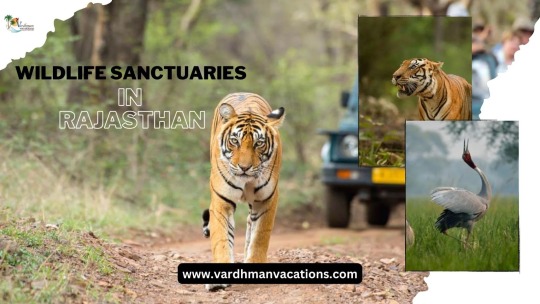
Rajasthan, a land of vibrant cultures and impressive landscapes, is not only renowned for its historical forts and palaces but also for its rich biodiversity. Amidst the vast deserts and arid plains, lies a network of wildlife sanctuaries, serving as havens for numerous species of flora and fauna. These sanctuaries, scattered across the state, play a pivotal role in conserving the region's ecological balance and fostering sustainable tourism. In this comprehensive exploration, we delve into the diverse ecosystems and conservation efforts within the Wildlife sanctuaries in Rajasthan.
Rajasthan Wildlife Tour Packages
When planning your visit to Rajasthan, be sure to check out the top must-see wildlife sanctuaries that promise an unforgettable experience. Here are some of the best wildlife sanctuaries in Rajasthan that you should not miss in 2024:
Ranthambore National Park
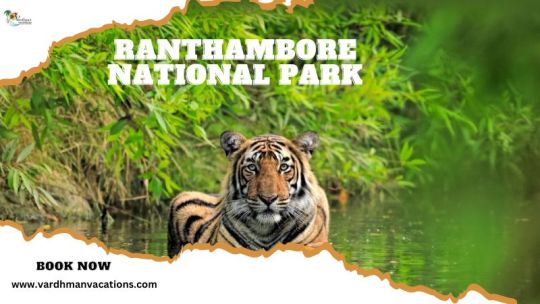
One of the most famous wildlife sanctuaries in Rajasthan is Ranthambore National Park. Located near the town of Sawai Madhopur, this park is home to the majestic Bengal tiger, along with other wildlife such as leopards, sloth bears, and various species of birds. Visitors can enjoy thrilling safaris through the park's rugged terrain, providing an up-close look at these magnificent creatures in their natural habitat.
Sariska Tiger Reserve
Another popular wildlife sanctuary in Rajasthan is the Sariska Tiger Reserve. Situated in the Alwar district, this reserve was once a hunting ground for the royals of Rajasthan but is now a protected area aimed at conserving the endangered Bengal tiger. In addition to tigers, Sariska is also home to leopards, hyenas, and a variety of bird species, offering visitors a unique and thrilling wildlife experience.
Keoladeo National Park
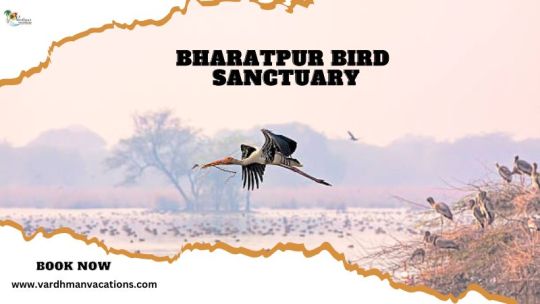
Keoladeo National Park, also known as Bharatpur Bird Sanctuary, is a paradise for bird watchers. Located in Bharatpur, this park is a UNESCO World Heritage Site and is home to over 370 species of birds, including migratory birds that visit the park during the winter months. Visitors can explore the park on foot or by cycle rickshaw, immersing themselves in the sights and sounds of the diverse bird population.
Conclusion
Wildlife Sanctuaries in Rajasthan offer a unique opportunity to experience India's wildlife's natural beauty and diversity. Whether you're a wildlife enthusiast or simply looking to explore the great outdoors. As stewards of these pristine landscapes, we must uphold our commitment to conservation and sustainable tourism, ensuring that future generations can continue to marvel at the wonders of Rajasthan wildlife sanctuaries. Through collective efforts and environmental stewardship, we can safeguard these invaluable treasures and celebrate the magnificence of nature in all its glory. a visit to these sanctuaries is sure to be an unforgettable experience. Plan your trip to Rajasthan in 2024 and embark on a wildlife adventure like no other!
0 notes
Text

#rajasthan tour package#golden triangle tour packages#rajasthan wildlife safari tour#bharatpur bird sanctuary#tour planner rajasthan#trip planner rajasthan
3 notes
·
View notes
Text
Rajasthan Wildlife Safari Tour
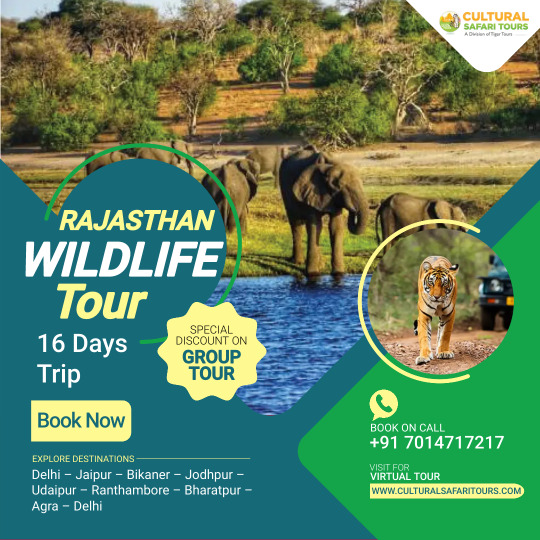
Rajasthan Wildlife Tour package is designed for the travellers who want to explore and feel the richness of Rajasthan's history, culture and wildlife through the monuments and by visiting the wildlife sanctuary.
Best Ranthambore Safari Booking Service
Contact us
Name: Sudhir Sharma
Website: https://www.culturalsafaritours.com
Email: [email protected]
CALL US: +91 7014717217, +91 9414030306
#Rajasthan Wildlife Tour#Wildlife Tour#famous wildlife sanctuaries in india#National Parks and Wildlife Sanctuaries in Rajasthan#Rajasthan Wildlife Safari Tour
5 notes
·
View notes
Text

Pallid harrier, Tal Chhapar, Rajasthan, October, 2024
#birds of prey#big birds#birds#pallid harrier#harrier#preying#perches#tal chhapar#rajasthan#india#wildlife#sanctuary#colors#focus#wild#bird watching#predators
0 notes
Text
India is a land of diverse landscapes and rich biodiversity. One of the best ways to experience this natural beauty is by visiting its numerous national parks. Here is the list of 30 Best National Parks in India to make your travel smooth and hassle-free.
#national parks in india#kanha tiger reserve#ranthambore national park rajasthan#tiger reserve in india#national park in madhya pradesh#difference between national park and wildlife sanctuary#total national park in india
0 notes
Text
#ranthambore national park#ranthambore national park rajasthan#ranthambore tiger reserve sawai madhopur#ranthambore tiger reserve rajasthan#tiger reserves in india#national parks in india#wildlife sanctuary and national park in india#best tiger reserve in india#ranthambore national park tiger safari#tiger reserve in rajasthan#best national park in india
0 notes
Text
Tal Chhapar Blackbuck Sanctuary | Wildlife Sanctuary Rajasthan
Rajasthan, known for its vibrant culture, majestic forts, and desert landscapes, is also home to some of India's most captivating wildlife sanctuaries. Among these, the Tal Chhapar Blackbuck Sanctuary stands out as a haven for nature lovers and wildlife enthusiasts. In this blog, we delve into the wonders of this sanctuary, highlighting its unique features and the unforgettable experiences it offers, all through the lens of Asian Adventures, a renowned name in wildlife tourism.
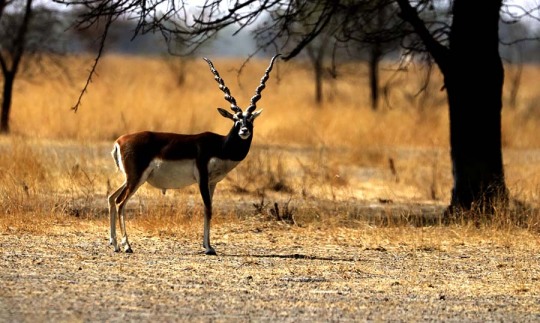
The Charismatic Blackbucks of Tal Chhapar
Tal Chhapar Sanctuary, located in the Churu district of Rajasthan, is a testament to the state's rich biodiversity. Spread over an area of approximately 7 square kilometers, this sanctuary is primarily known for its population of blackbucks, an elegant antelope species. The sanctuary's flat terrain, interspersed with grasslands and shrubs, provides an ideal habitat for these graceful creatures.
Asian Adventures, with its expertise in wildlife tours and conservation, offers an immersive experience at Tal Chhapar Sanctuary. Visitors are treated to guided safaris, allowing them to observe blackbucks in their natural environment. The sight of these antelopes gracefully leaping across the grasslands is a spectacle that leaves a lasting impression on every visitor.
A Haven for Avian Diversity
Apart from blackbucks, Tal Chhapar Sanctuary is also a paradise for birdwatchers. The sanctuary is home to a diverse range of avian species, making it a hotspot for birding enthusiasts. During the winter months, migratory birds flock to the sanctuary, adding to its already impressive bird population.
Asian Adventures' expert guides lead birding excursions within the sanctuary, offering insights into the various bird species that call Tal Chhapar home. From majestic raptors like the Eastern Imperial Eagle to colorful residents like the Indian Roller, every bird sighting is a delight for nature lovers and photographers alike.
Conservation and Community Engagement
Asian Adventures goes beyond conventional tourism by promoting conservation efforts and engaging with local communities. At Tal Chhapar Sanctuary, they collaborate with conservation authorities to support initiatives aimed at protecting the area's wildlife and habitats. Visitors have the opportunity to learn about these conservation projects and contribute to them, fostering a sense of responsibility towards nature.
Moreover, Asian Adventures prioritizes sustainable tourism practices that benefit local communities. By partnering with local guides and accommodations, they ensure that tourism generates positive impacts, both economically and environmentally.
Immersive Experiences Beyond Wildlife
While wildlife is the highlight of a visit to Tal Chhapar Blackbucks Sanctuary, Asian Adventures curates holistic experiences that showcase the region's cultural and historical heritage. Visitors can explore nearby villages, interact with locals, and savor authentic Rajasthani cuisine, adding depth to their journey beyond wildlife encounters.
Tal Chhapar and Beyond In addition to Tal Chhapar, Asian Adventures offers tours to other wildlife sanctuaries across India, including the renowned Hampi Wildlife Sanctuary. Nestled in Karnataka's Hampi region, this sanctuary is celebrated for its diverse wildlife, ancient ruins, and scenic landscapes. Whether it's witnessing elephants in their natural habitat or exploring Hampi's archaeological wonders, Asian Adventures crafts unforgettable journeys that blend nature, culture, and adventure.
Conclusion
The Tal Chhapar Blackbuck Sanctuary, with its captivating wildlife and Asian Adventures' expertise in sustainable tourism, epitomizes the harmony between humans and nature. Through responsible travel practices, immersive experiences, and a commitment to conservation, visitors not only witness the beauty of Rajasthan's wilderness but also contribute to its preservation for generations to come. As Asian Adventures continues to inspire travelers with its passion for wildlife and culture, Tal Chhapar remains a timeless gem in India's wildlife tourism landscape.
#birding in desert national park#tal chhapar sanctuary#birds in rajasthan desert#bird watching in rajasthan#tal chappar sanctuary#tal chhapar blackbuck sanctuary#birding near bikaner#birding hotspots near bikaner#jorbeer birding#bird watching tours bikaner#birdwatching at jorbeer#wildlife sanctuary rajasthan
0 notes
Text
Kumbhalgarh Fort: A Journey through History and Architecture
Nestled amidst the picturesque Aravalli Hills in Rajasthan, India, stands the magnificent Kumbhalgarh Fort, an architectural marvel that resonates with the rich history of the region. This imposing structure has stood the test of time, bearing witness to countless stories of valor, culture, and innovation. In this article, we will delve into the fascinating history, awe-inspiring architecture,…
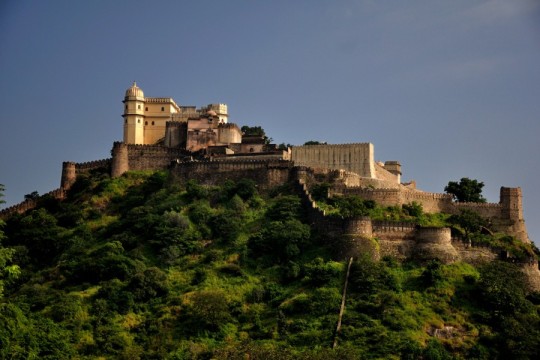
View On WordPress
0 notes
Text
I Visited The Second Longest Wall In The World
"There’s Magic In Forts"
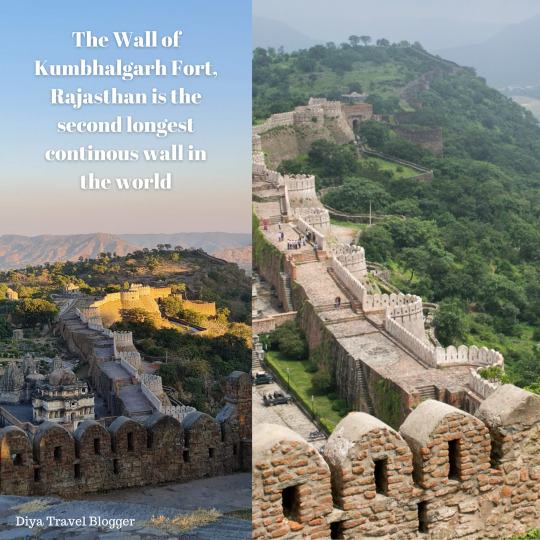


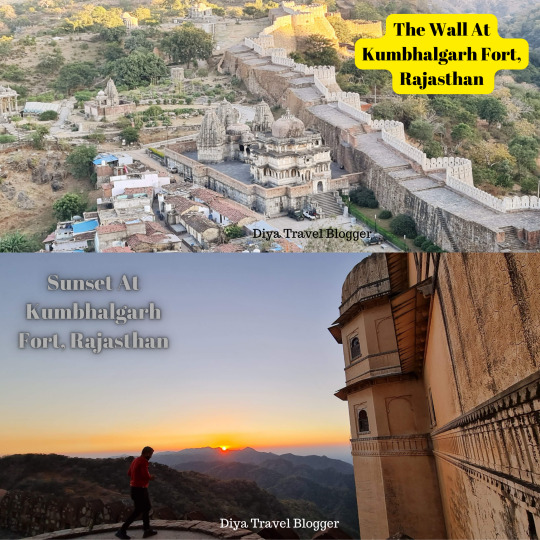
In the topmost video clip, I can be seen walking at Kumbhalgarh Fort along with my husband while in the bottom most video clip, our wonderful guide can be seen talking to my husband, explaining about the glorious history of this place.
*********************************************
Some very interesting facts about this place:
* The wall at Kumbhalgarh Fort stretches over 36 kilometers, second only to Great Wall of China.
* This Fort was built by Rana Kumbha, a ruler of the Mewar region in the North Western State of Rajasthan, India.
* The wall has never been breached.
* It served as a refuge for the rulers of Mewar.
* There are 360 temples in that area.
* The Fort has seven gates.
* The Fort is surrounded by a Wildlife Sanctuary.
* A spectacular light & sound show is held every evening in the complex depicting the history of the place.
* It is a UNESCO World Heritage Site since 2013.
Source: Times Of India
See you soon, my dear friends 🤗
#incredibleindia#travelblogger#travel destinations#bharat#traveller#destination#travelphotography#travel video#travels#travel blog#travelpics#travel india#travel photo#travelling#travelblog#tourist#tourism#india#outdoor#adventures
107 notes
·
View notes
Text
Experience the Thrill of Tiger Safaris on India’s Wildlife Holidays

India, a land of diverse cultures, vibrant landscapes, and majestic creatures, is an unparalleled destination for wildlife enthusiasts. Among its many treasures, tiger safaris stand out as a thrilling experience that lets you witness the king of the jungle in its natural habitat. If you're looking to explore the wilderness, "India Wildlife Holidays" offer the perfect escape. And when it comes to curating these magical journeys, OrangeDMC emerges as the go-to travel company, ensuring an unforgettable adventure.
Why Choose India for Wildlife Holidays?
Rich Biodiversity
India is home to over 7% of the world’s biodiversity. With its lush forests, vast grasslands, and towering mountains, the country offers habitats to a variety of flora and fauna, including the elusive Bengal tiger.
Unique Wildlife Experiences
From the snow leopards of the Himalayas to the majestic elephants of South India, India’s wildlife is as diverse as its people. Tiger safaris are the crown jewel of these experiences, promising adrenaline-pumping encounters with the world’s most regal predator.
Perfect Blend of Adventure and Comfort
India’s wildlife sanctuaries and national parks are equipped with world-class infrastructure, offering luxurious accommodations, expert guides, and unforgettable safari experiences.
Top Destinations for Tiger Safaris in India
Ranthambore National Park, Rajasthan
One of the most famous tiger reserves in India, Ranthambore offers a great chance of spotting tigers against the backdrop of ancient ruins. The park’s picturesque landscapes and diverse wildlife make it a must-visit for anyone planning an "Indian wildlife holiday."
Jim Corbett National Park, Uttarakhand
Known as India’s first national park, Jim Corbett is where conservation history began. While tiger sightings are not guaranteed, the thrill of exploring the dense forests is unmatched.
Bandhavgarh National Park, Madhya Pradesh
This park boasts one of the highest tiger densities in India, making it a top choice for photographers and wildlife lovers. The striking landscapes and ancient caves add to its allure.
Kanha National Park, Madhya Pradesh
The inspiration behind Rudyard Kipling’s The Jungle Book, Kanha is a haven for tigers, leopards, and barasinghas (swamp deer). Its lush sal forests provide an idyllic setting for safaris.
Sundarbans National Park, West Bengal
For a unique tiger safari experience, the Sundarbans offer boat safaris through the mangrove forests, where you might catch a glimpse of the elusive Royal Bengal Tiger.
The Thrill of a Tiger Safari
The Chase
Tiger safaris are not just about spotting a tiger but about the anticipation and excitement of the chase. Every rustle in the bushes, every alarm call of a deer, and every paw print in the mud keeps your heart racing.
The Sighting
The moment you see a tiger in the wild is pure magic. The majestic animal walking gracefully through its kingdom is an experience that leaves an indelible mark on your soul.
Expert Guidance
OrangeDMC ensures that every safari is guided by trained naturalists who not only enhance your chances of spotting a tiger but also educate you about the ecosystem and conservation efforts.
Why Choose OrangeDMC for Your Wildlife Holiday?
Customizable Packages
OrangeDMC specializes in creating tailor-made wildlife holiday packages that cater to your preferences and budget. Whether you’re a solo traveller or a family seeking adventure, they’ve got you covered.
Experienced Guides and Naturalists
With a team of experienced guides, OrangeDMC ensures that you gain a deep understanding of the flora and fauna while maximizing your chances of tiger sightings.
Luxury and Comfort
From eco-lodges to luxury resorts, OrangeDMC provides accommodations that blend comfort with sustainability, ensuring a guilt-free, immersive experience.
Seamless Travel Experience
With their meticulous planning and attention to detail, OrangeDMC takes care of everything—from permits to transportation—so you can focus on enjoying your adventure.
For complete guidance, visit here: https://www.orangedmc.com/tiger-safari-india.html
What to Expect on Your India Wildlife Holiday
Early Morning and Evening Safaris
Tiger safaris are typically conducted during the more incredible hours of the day when tigers are more active. Expect to start your day early and end it with the golden hues of a sunset.
Close Encounters with Wildlife
Apart from tigers, you’ll encounter a variety of wildlife, including leopards, sloth bears, deer, and exotic birds.
Photography Opportunities
The diverse landscapes and rich wildlife provide ample opportunities for photography. Whether you’re an amateur or a professional, you’ll leave with a treasure trove of memories.
Tips for a Successful Tiger Safari
Pack Smart
Carry comfortable clothing, sturdy shoes, binoculars, and a good camera. Don’t forget sunscreen and insect repellent.
Be Patient
Wildlife sightings are unpredictable. Embrace the journey, and don’t be disheartened if you don’t spot a tiger immediately.
Follow the Rules
Always adhere to the park’s guidelines to ensure your safety and the well-being of the animals.
Sustainability and Conservation
By choosing OrangeDMC for your "India wildlife holidays," you’re supporting eco-tourism and conservation efforts. Their commitment to sustainability ensures that these experiences remain available for generations to come.
Conclusion
Tiger safaris in India are not just about spotting a tiger; they’re about immersing yourself in the wild, understanding the delicate balance of nature, and creating memories that last a lifetime. With OrangeDMC as your trusted travel partner, your "India wildlife holiday" promises to be an adventure filled with wonder, excitement, and a deep connection to nature.
#india wildlife holidays#tiger safari india#tiger safaris india#indian national park#indian tiger reserves national parks
0 notes
Text
The Great Wall of India: Why You Should Visit Kumbhalgarh from Udaipur

Kumbhalgarh Fort, often referred to as the "Great Wall of India," is a stunning testament to the architectural brilliance and rich history of Rajasthan. Located just 85 kilometers from Udaipur, this UNESCO World Heritage Site is an unmissable destination for history enthusiasts, architecture lovers, and adventure seekers. Choosing a reliable Udaipur to Kumbhalgarh taxi service ensures a comfortable and convenient journey, allowing you to explore this iconic site and its surroundings to the fullest.
What Makes Kumbhalgarh Fort Unique?
The Second-Longest Wall in the World
The wall of Kumbhalgarh Fort stretches over 36 kilometers, making it the second-longest continuous wall in the world after the Great Wall of China. Constructed in the 15th century by Rana Kumbha, this wall is not just a defensive structure but also a marvel of engineering.
Rich History and Cultural Significance
Kumbhalgarh Fort played a pivotal role in the history of Mewar. It served as a refuge for rulers during times of war and is famously known as the birthplace of Maharana Pratap, one of India’s most celebrated warriors.
Architectural Grandeur
The fort houses more than 360 temples, palaces, and water storage systems, showcasing intricate designs and robust construction. Its strategic location atop the Aravalli hills provides panoramic views of the surrounding countryside.
How to Reach Kumbhalgarh from Udaipur
The easiest way to travel from Udaipur to Kumbhalgarh is by road. Opting for taxi booking online in Udaipur ensures you have a hassle-free journey tailored to your needs. Professional taxi services offer:
Comfortable vehicles
Experienced drivers
Flexible itineraries
A taxi service allows you to enjoy scenic stops along the way and ensures timely arrival at the fort.
Top Reasons to Visit Kumbhalgarh
1. A Journey Through History
Visiting Kumbhalgarh Fort is like stepping back in time. The fort’s massive gates, grand palaces, and ancient temples speak volumes about its historical and cultural importance.
2. The Great Wall Experience
Walking along the fort’s massive wall is an experience like no other. The wall’s sheer size and the views it offers are awe-inspiring and make for unforgettable memories.
3. Stunning Panoramic Views
Situated at an altitude of 1,100 meters, the fort offers breathtaking views of the Aravalli hills and the dense forests surrounding it. The sunsets from the fort are particularly mesmerizing.
4. A UNESCO World Heritage Site
Kumbhalgarh Fort is part of the "Hill Forts of Rajasthan" UNESCO World Heritage Sites, cementing its status as a global treasure worth exploring.
5. Proximity to Kumbhalgarh Wildlife Sanctuary
Combine your visit to the fort with a stop at the nearby Kumbhalgarh Wildlife Sanctuary. It’s a haven for wildlife enthusiasts and nature lovers.
What to See Inside Kumbhalgarh Fort
Palaces
The Badal Mahal (Palace of Clouds) is a highlight of the fort. Divided into two sections – for men and women – the palace features colorful murals and intricate architecture.
Temples
The fort is home to over 360 temples, including the revered Neelkanth Mahadev Temple, dedicated to Lord Shiva.
Massive Gates
The main entrance to the fort, known as the Ram Pol, is a testament to its defensive strength. Other gates, such as the Hanuman Pol and Bhairon Pol, add to its architectural beauty.
Water Reservoirs
The fort’s ingenious water storage systems ensured a constant supply of water, even during sieges. These reservoirs are engineering marvels worth exploring.
Tips for Visiting Kumbhalgarh Fort
Best Time to Visit
The ideal time to visit is between October and March, when the weather is pleasant. The cooler months enhance the experience of exploring the fort’s vast expanse.
Dress Comfortably
Wear comfortable clothing and sturdy footwear as exploring the fort involves walking and climbing.
Hire a Guide
To fully appreciate the fort’s history and architecture, consider hiring a local guide. They provide valuable insights and make your visit more enriching.
Pack Essentials
Carry water, snacks, sunscreen, and a hat to stay comfortable during your visit.
Benefits of Choosing a Taxi Service for Your Trip
Opting for a professional Udaipur to Kumbhalgarh taxi service enhances your travel experience in several ways:
Convenience
A taxi ensures you can travel at your own pace, stopping at scenic spots or attractions en route.
Safety
Experienced drivers familiar with the route and terrain ensure a safe journey.
Customizable Itinerary
A taxi service allows you to plan your trip according to your preferences, making it a stress-free experience.
Online Booking Options
With taxi booking online in Udaipur, you can easily compare prices, choose your vehicle, and book in advance, ensuring a smooth travel experience.
Nearby Attractions
Haldi Ghati
Located en route to Kumbhalgarh, Haldi Ghati is a historically significant site that tells the story of Maharana Pratap’s bravery.
Ranakpur Jain Temple
Famous for its intricate marble architecture, this temple is a serene stop on your journey.
Kumbhalgarh Wildlife Sanctuary
Add a touch of adventure to your trip by exploring this sanctuary, home to diverse flora and fauna.
Conclusion
The "Great Wall of India" at Kumbhalgarh is a destination that offers a blend of history, architecture, and natural beauty. With its rich cultural significance and stunning landscapes, it’s a must-visit on any Rajasthan itinerary. By choosing a reliable Udaipur to Kumbhalgarh taxi service and leveraging taxi booking online in Udaipur, you can ensure a seamless and enjoyable journey. Make Kumbhalgarh Fort a part of your travel plans and immerse yourself in the grandeur of Rajasthan’s heritage.
0 notes
Text
Wildlife Photography Safaris in Jawai: Packages Curated by Travel Agents

Embarking on a wildlife safari is an unforgettable experience, blending the thrill of exploring untamed wilderness with the joy of encountering majestic animals in their natural habitat. For travelers seeking unique safari adventures, Wildlife Safari in Jawai and services offered by a Travel Agency in Rajasthan promise an extraordinary journey. Here’s a detailed guide to top destinations and tips to plan your perfect wildlife safari.
Why Choose Rajasthan for Wildlife Safaris
Rajasthan, known for its royal heritage, is also a treasure trove of diverse wildlife. Its blend of rugged landscapes, lush sanctuaries, and rare species make it a dream destination for nature lovers. A Travel Agency in Rajasthan can expertly navigate the state’s vast offerings, ensuring an enriching safari experience.
Jawai: A Hidden Gem for Wildlife Enthusiasts
Wildlife Safari in Jawai: What Makes It Special?
Jawai, often referred to as the “Land of the Leopards,” is a must-visit destination for wildlife enthusiasts. Unlike other safari destinations, Jawai offers a unique ecosystem where humans and wildlife coexist harmoniously. The area is renowned for its thriving leopard population, making it a hotspot for thrilling leopard sightings.
Key highlights of a Wildlife Safari in Jawai include:
Leopard Spotting: Jawai’s granite hills and caves are home to leopards that roam freely, providing unmatched viewing opportunities.
Birdwatching: Jawai Dam attracts a wide variety of migratory birds, including flamingos, cranes, and pelicans.
Cultural Blend: Travelers can experience the Rabari community’s rich culture, which thrives alongside the wildlife.
Other Top Wildlife Safari Destinations in Rajasthan
While Jawai stands out for its leopards, Rajasthan offers several other incredible destinations for wildlife safaris. Here’s a quick look:
Ranthambore National Park
One of India’s most famous reserves, Ranthambore is known for its majestic tigers. Located near Sawai Madhopur, the park offers a rich mix of history and wildlife, with ruins of an ancient fort dotting the landscape. A Travel Agency in Rajasthan can help secure entry permits and arrange jeep safaris for optimal wildlife viewing.
Sariska Tiger Reserve
Situated in the Alwar district, Sariska is another excellent destination for tiger sightings. Apart from tigers, the reserve is home to leopards, hyenas, and various bird species.
Keoladeo National Park
A UNESCO World Heritage Site, Keoladeo is a paradise for birdwatchers. This wetland sanctuary hosts thousands of migratory birds during the winter, making it a must-visit for avian enthusiasts.
Desert National Park
For those looking to explore Rajasthan’s desert ecosystem, this park near Jaisalmer offers a unique safari experience. Spot rare species like the Great Indian Bustard and blackbucks.
How a Travel Agency in Rajasthan Simplifies Your Safari
Planning a wildlife safari can be daunting, especially when considering permits, transportation, and accommodation. A Travel Agency in Rajasthan plays a crucial role in ensuring a seamless experience by:
Customizing Itineraries: Tailoring trips based on traveler preferences, whether it’s a luxurious stay or a budget-friendly safari.
Handling Permits: Navigating the permit process for national parks and wildlife reserves.
Providing Expert Guides: Offering knowledgeable guides to enhance the safari experience with insights into animal behavior and local culture.
Best Time for Wildlife Safari in Rajasthan
Seasonal Recommendations
Winter (October to March): Ideal for safaris, as animals are more active, and the weather is pleasant. This is also the best time for birdwatching at Jawai Dam and Keoladeo National Park.
Summer (April to June): While the heat can be intense, this season offers higher chances of spotting tigers and leopards, as they frequent waterholes.
Tips for an Unforgettable Wildlife Safari
Plan with a Trusted Travel Agency in Rajasthan
Collaborate with a reputable travel agency to ensure all logistics are handled, allowing you to focus solely on the experience.
Pack Wisely
Light, neutral-colored clothing for blending with the environment.
Binoculars and cameras to capture sightings.
Sturdy shoes and sunscreen for comfort.
Follow Safari Etiquette
Maintain silence during safaris to avoid disturbing wildlife.
Avoid littering and respect the natural environment.
Listen to your guide for a safe and enjoyable experience.
Beyond Wildlife: Exploring Rajasthan’s Heritage
Combine your Wildlife Safari in Jawai or other destinations with a cultural tour of Rajasthan. From the majestic forts of Jaipur to the serene lakes of Udaipur, a Travel Agency in Rajasthan can craft a holistic itinerary blending adventure with history.
Conclusion
A wildlife safari in Rajasthan, especially in Jawai, offers an unparalleled blend of adventure, nature, and culture. Whether you’re seeking a close encounter with leopards or a peaceful escape into birdwatching, this region promises to exceed expectations. Partnering with an experienced Travel Agency in Rajasthan ensures your safari adventure is seamless, memorable, and truly extraordinary.
0 notes
Text
TOP 5 NATIONAL PARKS TO VISIT IN INDIA
India is a land of diverse landscapes and rich biodiversity, making it a paradise for nature enthusiasts and wildlife lovers. The country boasts a remarkable collection of national parks and wildlife sanctuaries that house a wide range of flora and fauna. From the majestic Bengal tigers to the graceful Indian rhinoceros, these protected areas offer a glimpse into the incredible wildlife that India is home to. If you're seeking an unforgettable adventure in the lap of nature, here are the top 5 national parks in India that promise an enthralling wildlife experience. Get ready for an expedition like no other!
Jim Corbett National Park
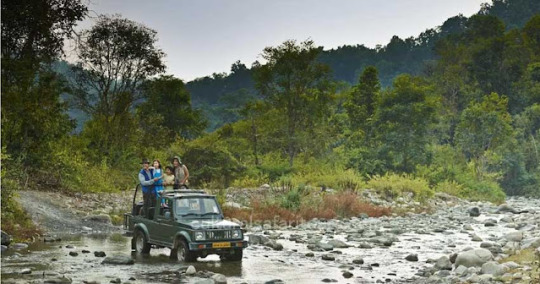
Located in the state of Uttarakhand, the Jim Corbett National Park is India's oldest national park and a haven for wildlife enthusiasts. Named after the legendary British hunter turned conservationist, Jim Corbett, this park spans across the foothills of the Himalayas. The park is renowned for its population of the elusive Bengal tiger, making it a prime destination for tiger enthusiasts. To enhance your experience, engage in an online Jim Corbett Safari Booking, where you'll have the opportunity to explore the diverse landscapes and spot various species including leopards, elephants, and numerous bird species.
Ranthambore National Park
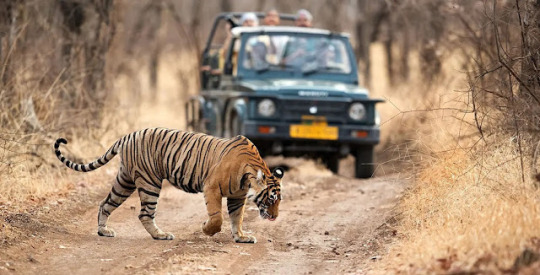
Situated in the royal state of Rajasthan, Ranthambore National Park is a testament to the grandeur of the Indian wilderness. Known for its historic Ranthambore Fort that stands amidst the lush forests, this park is a treasure trove of biodiversity. The park's star attraction is the majestic Bengal tiger, and Ranthambore Safari Booking provides an exhilarating chance to witness these predators in their natural habitat. With its unique blend of history and nature, Ranthambore offers an unparalleled wildlife experience.
Bandhavgarh National Park
In the heart of Madhya Pradesh lies the captivating Bandhavgarh National Park, a place where nature's beauty and wildlife's majesty converge. This park is renowned for having one of the highest densities of tigers in India. The Bandhavgarh Safari Booking allows you to traverse through dense forests, open grasslands, and serene water bodies while searching for tigers, leopards, and various deer species. The ancient Bandhavgarh Fort adds a touch of history to this natural wonderland, creating a truly unique ambiance.
Kaziranga National Park
Venture to the northeastern state of Assam, and you'll discover the UNESCO World Heritage-listed Kaziranga National Park. This park is a sanctuary for the rare and endangered Indian one-horned rhinoceros, making it a critical conservation site. The park's marshy grasslands and dense forests provide a unique habitat for various wildlife species. Engage in a Kaziranga National Park Safari Booking to witness not only the impressive rhinoceros but also wild elephants, Asiatic water buffaloes, and a plethora of bird species.
Periyar National Park
Down south in the state of Kerala, Periyar National Park offers a distinct wildlife experience amidst the Western Ghats' lush greenery. What sets this park apart is its picturesque location around the Periyar Lake, where you can enjoy a boat safari while spotting animals at the water's edge. The park is a sanctuary for various mammals, including the endangered Nilgiri tahr and the elusive Indian wild dog. A Periyar National Park Safari Booking lets you explore the park's unique ecosystem while cruising through its tranquil waters.
Conclusion
Embarking on an India wildlife tour to these top 5 national parks promises an adventure of a lifetime. From the royal Bengal tigers of Ranthambore to the rare Indian rhinoceros of Kaziranga, each park offers a unique opportunity to connect with nature's wonders. Engage in Jim Corbett Safari Booking, Ranthambore Safari Booking, Bandhavgarh Safari Booking, Kaziranga National Park Safari Booking, and Periyar National Park Safari Booking to fully immerse yourself in the beauty and diversity of India's wildlife. These national parks not only showcase the splendor of the country's natural heritage but also play a crucial role in conserving its precious flora and fauna. So, gear up for a wild adventure and let India's national parks leave an indelible mark on your soul.
0 notes
Text
Tal Chhapar
Tal Chhapar is a semi-arid village about 225 kms and almost 4.5 hours by car from Jaipur in the Churu district of north Rajasthan. The roads aren't great and combined with the indisciplined traffic, intense heat, and the blazing sun, the 4.5 hours seem much longer than they actually are. Chhapar is home to many native and migratory birds along with the blackbucks and nilgais that form the majority of the local wildlife.
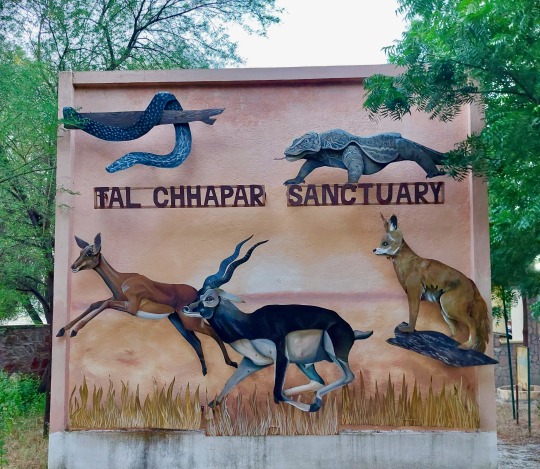
Probably the best time to visit Chhapar is in December, when one can spot many varieties of migratory birds. However, October onwards is generally considered a good time to visit for birding. Even though the number of birds is less, one can spot more variety during this time. Chhapar can get extremely hot and dusty, especially during the afternoons. In winters, the temperature also drops quite a bit. Ker and Sangri trees dot the landscape with intermittent sprinkling of stunted shrubs and bushes. Tal Chhapar in terms of birding is divided into 3 adjoining but distinct areas - the salt pans, the Tal Chhapar sanctuary, and the Gaushala lands. Each of these have their own charm and native residents. The presence of water bodies, plenty of prey, and natural cover ensure that the big birds of this area have ample reasons to stick around.
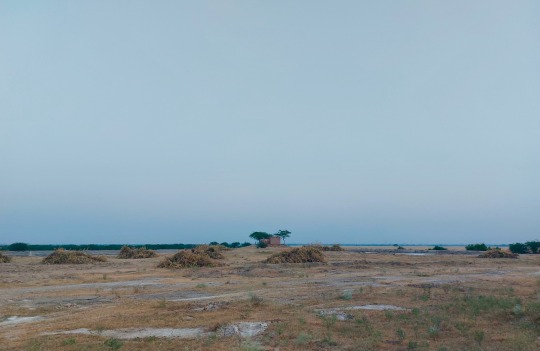

The salt pans area is adjacent to the sanctuary and has many waders (big and small) and ducks in addition to other birds. The underground brine oozes onto the surface where it's left to dry under the sun in the salt fields. The water evaporates, leaving behind the white salt. This salt is then taken to processing units where it's packed and sold. Early morning is the best to visit the pans; the forenoon and afternoon glare from the pans is blinding. This area abounds in small passerine birds and has a large number of water bodies and ponds. There are also many wells and step wells, the walls of which provide nesting space to the raptors.
The Tal Chhapar sanctuary is rather small, only about 10 sq. kms but it more than makes up for its size in terms of birding experience. It's an open grassland that offers great visibility for long distances owing to its flatness. This sanctuary used to be the royal hunting grounds of the local maharajas and boasts of a large number of blackbucks and birds, especially raptors. While the grass here isn't tall enough to hide the wildlife completely, it does provide cover to the foxes, hares, and francolins. It resembles the African savannah in terms of color and density. Early mornings and late evenings are great times of the day to see the birds in the sanctuary. Morning safaris are from 6:30 to 9 am and evening safaris are from 4 to 6:30 pm. A big prosopis tree houses spotted owlets right at the entrance of the safari. Within the sanctuary, there are many watering holes (one of which is named after Dr. Salim Ali). There are some pockets that are cordoned off to prevent overgrazing by the blackbucks. In the absence of natural predators, the blackbuck population has really taken off here. The govt. now plans to relocate some of them to a different site to prevent overcrowding. There are perches put up at regular distances to make it easier for both birds and bird watchers.


The third area in Chhapar is the Gaushala land, that's covered by thorny shrubs and stunted trees. Large tracts of this land are owned by the surrounding cow shelter homes, hence the name gaushala. Mostly you are on your own, but if you come across one of the gaushala members, you have to pay Rs. 200 as entry fee. This area again is divided into multiple sub-areas. On one side you have a zone for carcasses that abounds in carrion-eating birds such as vultures and ibises. In the middle, you have a relatively cooler area with taller trees that abounds in smaller birds such as the Indian spotted creeper, hoopoes, nilgais, and blackbucks. The last zone is a relatively hotter zone that has eagles, lizards, snakes, and foxes. It's here that you can hope to come across raptors with kills.
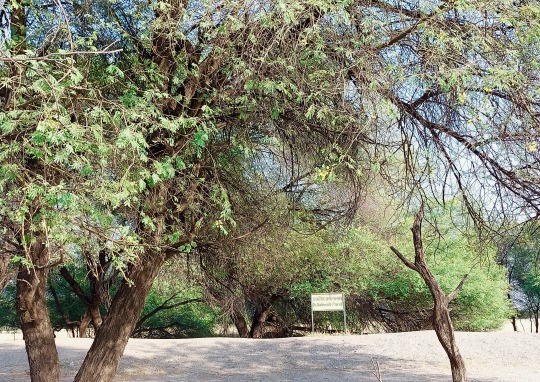
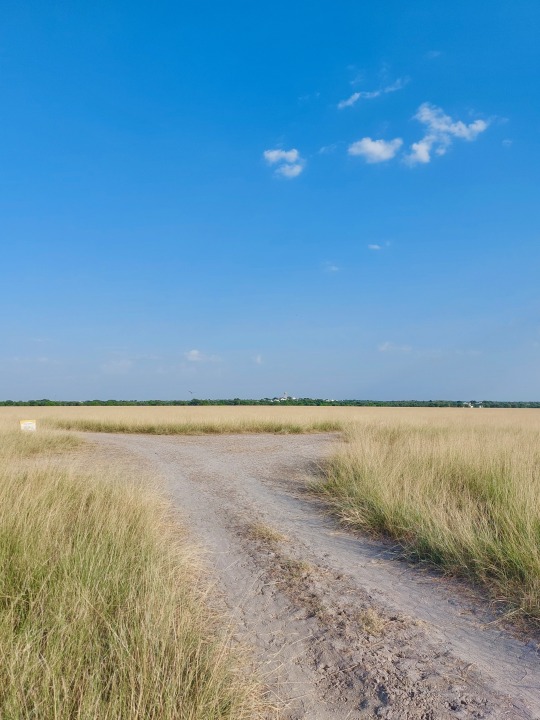
We stayed for 2 days and 2 nights at the Raptor's Inn (different from Raptor's Paradise closer to the highway) in Chhapar which is managed by Mr. Atul (+91-8826907085). It's a small place, similar to a homestay. They provide meals 3 times a day with a fixed menu. You can spend evenings catching up with guides and other birders. We met a gentleman from Gujarat who has been visiting Tal Chhapar for 17 years. The homestay folks arrange safaris in all the three areas at all times of the day, and can book your sanctuary safaris too. The safaris are usually in open Gypsy or closed cars such as Bolero. Most of the guides are locals and quite knowledgeable about the wildlife. Just as the focus in other national parks is on sighting big cats during safaris, the focus of the Tal Chhapar guides is to sight raptors and birds of prey. The Tal Chhapar sanctuary is one of the few places in India that provides a focused birding experience. It's definitely worth a visit if you are keen on spotting birds of prey.
#Chhapar#Tal Chhapar#Rajasthan#blackbuck#sanctuary#raptors#Raptor's Inn#birds of prey#big birds#birdwatching#birding#nilgai#summer#winter#wildlife#travel#Jaipur#salt pans#salt#carcass#carrion#desert#semi-arid#hot climate#Gypsy#safari
1 note
·
View note
Text
Top National Parks in India for an Unforgettable Tiger Rendezvous
Are you ready for an unforgettable jungle safari experience? If the thought of coming face-to-face with the majestic Bengal Tiger excites you, then you’ll love our roundup of the top 7 national parks in India!
India is not just a land of awe-inspiring monuments and cultural diversity but also a haven for nature lovers with its incredible wildlife parks. And while these parks are home to a range of fascinating creatures, it's the tiger sightings that make the experience truly extraordinary.
1. Jim Corbett National Park, Uttarakhand

Jim Corbett National Park, once called ‘Hailey National Park,’ is nestled in the gorgeous foothills of Uttarakhand’s Himalayas. Known as one of India’s oldest national parks, it’s a sanctuary for the elusive Bengal Tiger and home to a variety of wildlife such as elephants, rhinoceros, leopards, and even black bears. The dense deciduous forests add to the beauty and adventure of the safari.
Best Time to Visit: March – June
Ways to Explore: Gypsy/Jeep Safari, Canter Safari, and Elephant Safari
Entry Fee: Approx. INR 200 for Indian citizens; INR 900 for foreigners
Note: Some zones of Jim Corbett remain closed during monsoon season, with Jhirna, Sonanadi, and the newly opened Pakhro zone staying open.
2. Sundarbans National Park, West Bengal

Located in the vast Sundarbans Delta, this national park is famous for its lush mangrove forests and being the largest Bengal Tiger reserve. As you cruise along the waterways, you may spot a tiger hunting in its natural habitat. The park is also home to various species of birds, reptiles, and the fearsome saltwater crocodile.
Best Time to Visit: October – March
Ways to Explore: Boat Safari
Entry Fee: Visitors require a permit from the Divisional Forest Office.
Note: Only boat safaris are available in Sunderbans.
3. Ranthambore National Park, Rajasthan

Famous for its thriving tiger population, Ranthambore National Park combines history and nature in an unforgettable way. Situated in Sawai Madhopur, Rajasthan, this park gets its name from the ancient Ranthambore Fort within its grounds. Beyond tigers, visitors might encounter sloth bears, wild boars, marsh crocodiles, and spotted deer, making every safari unique.
Best Time to Visit: October – June
Ways to Explore: Jeep Safari, Canter Safari
Entry Fee: Approx. INR 100 for Indian citizens; INR 650 for foreigners
4. Bandhavgarh National Park, Madhya Pradesh

Once serving as a hunting ground for the Maharajas of Rewa, Bandhavgarh National Park now boasts the greatest concentration of Royal Bengal Tigers in India, with over 50 tigers. It’s also famous for its white tigers and draws wildlife enthusiasts from around the globe. Alongside tigers, you may spot leopards, sloth bears, wild boars, Indian bison, and a range of deer species. Birdwatchers will also find the park’s diverse birdlife quite impressive.
Best Time to Visit: October–February, and March–June
Ways to Explore: Gypsy/Jeep Safari, Elephant Safari
Entry Fee: Approx. INR 75 for Indian citizens; INR 500 for foreigners
5. Kanha National Park, Madhya Pradesh

Located in Madhya Pradesh’s Balaghat district, Kanha National Park is one of the outstanding tiger reserves in the country, sprawling across 940 square kilometres. It offers one of the best opportunities to view tigers in their natural habitat. As you journey through the thick forest, you’ll get a glimpse into the heart of jungle life. You may also encounter sloth bears, Indian wild dogs, wolves, jackals, and hyenas, making it an exciting safari destination.
Best Time to Visit: April–May
Ways to Explore: Jeep Safari, Elephant Safari
Note: The park remains open from 16th October to 15th June annually.
6. Pench National Park, Madhya Pradesh

Famous as the inspiration for Rudyard Kipling’s The Jungle Book, Pench National Park is a haven for Bengal Tigers. The park’s namesake river, Pench, runs through the forest, providing a water source for its inhabitants. Beyond the tiger sightings, you might spot wild boars, hyenas, and sloth bears. Pench also offers the unique experience of night safaris, making it a must-visit for adventure seekers.
Best Time to Visit: November–February and March–June
Ways to Explore: Gypsy/Jeep Safari
Entry Fee: Approx. INR 15 for Indian citizens; INR 150 for foreigners
7. Tadoba National Park, Maharashtra

Known as one of Maharashtra’s oldest and largest parks, Tadoba National Park, also called Tadoba Andhari Tiger Reserve, is home to a thriving tiger population. This park is India’s 47th tiger reserve and also houses wildlife such as jackals, sloth bears, barking deer, and langurs. The Tadoba River, running through the park, plays a key role in sustaining the park’s biodiversity.
Best Time to Visit: April–May, and November–February
Ways to Explore: Jeep/Gypsy Safari, Elephant Safari
Entry Fee: INR 20 per person
Note: Safari charges may increase on special occasions.
Curious to see the above mentioned National parks, then you must have a visa to enter India. But before applying for an e-visa, you should know what documents needed for indian visa. For e-visa, you must have a scanned copy of your passport with two blank pages and validity of six months, digital passport size photo, proof of financial, health insurance (if required).
Conclusion
Venturing into India’s national parks promises an exhilarating dive into the wilderness. Whether you're hoping to witness the grandeur of tigers up close, explore the vibrant diversity of wildlife, or just enjoy a peaceful retreat into nature, these parks cater to every type of traveller. Get ready to embark on an unforgettable safari that will immerse you in the awe-inspiring beauty of India’s natural landscapes.

0 notes
Text

#ranthambore national park#ranthambore national park rajasthan#ranthambore tiger reserve sawai madhopur#ranthambore tiger reserve rajasthan#tiger reserves in india#national parks in india#wildlife sanctuary and national park in india#best tiger reserve in india#ranthambore national park tiger safari#tiger reserve in rajasthan#best national park in india
1 note
·
View note